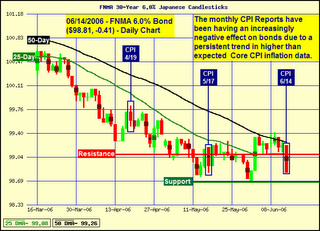I’m not convinced that we have seen the bottom in housing. I’m not convinced that we have seen a successful soft landing either. Things definitely slowed down going into the end of 2006, and they are definitely picking up again in early 2007. But I don’t see any reason to believe we will return to the hyperbolic growth we saw in previous years – or anything close to it. In fact, there still is some very real concern that we could see a more significant drop in house values.
The Federal Reserve is expected to keep rates flat all year. Some economists think we will see a rate cut late in the year, and some see a rate hike a possibility still. History tells us that the Fed usually starts cutting rates within 9-18 months of their last rate hike.
I have often said that with so many variables in the economy, and in the housing market specifically, all it can take is one environmental change to trigger a shift in consumer mentality, and thus consumer behavior. One of these variables that has re-entered the fold in the last few weeks is Wall Streets control over mortgage lending practices. With sub-prime lenders going out of business, Wall St. has raised concern with sub-prime mortgage backed securities. The lenders are responding by tightening their lending guidelines to uphold or improve their credit ratings.
A year ago, congress was advising the lending industry to do this, but lenders were actually relaxing guidelines in an effort to grab more of the shrinking volume of business. So with this pendulum swinging back the other way, you can expect the fringe of buyer access to be trimmed away, thereby reducing the pool of potential buyers, demand, housing liquidity, and ultimately prices. If lenders go too far too fast, either by their own proactive measures, or in response to Wall St. demand, we could see a shock to this system. And if the consumer perceives this to be significant, thats when the potential to freeze up and panic sets in.
Weakening prices slow what Paul Kasriel of Northern Trust refers to as ‘household deficit spending’, as homeowners cannot spend their home equity on other consumer purchases. If you don’t think this is a big deal, take note of the fact that the US Savings rate is at its lowest since the GREAT DEPRESSION, at a negative 0.5%. People are using their homes like ATM’s on a National level. Cutting off access to this slows spending, and the economy in general. Enough of this and the Fed is back into rate-cutting territory.
So while I hear agents advising their clients that “the bubble has not burst“, and that offers without contingency and 10% above the asking price are required “if you really want this home”, I don’t like anybody being too anxious to lead with logic when transacting in real estate. It is competitive right now, yes. But I’d be concerned that the housing market is making a head-fake here.

